Best Sonos speakers 2024
It's all about Sonos in this lineup.

1. At a glance
2. Best overall
3. Best budget choice
4. Best movability
5. Best portability
6. Best small soundbar
7. Best spatial audio
8. Best sound
9. Best home theater
10. Best accessory
Over the last few years, we've seen a resurgence in home speakers thanks to the rise of Alexa and Google Assistant. The idea of having a "smart speaker" is a lot more appealing to folks than a traditional "dumb speaker," which created a significant shift in the home audio market. Sonos has been making killer speakers since 2002 and, lately, has adapted to a changing industry. It's not just wireless anymore; in some cases, it's also portable, letting you hear excellent audio quality on the go. Plus, home theater choices give you plenty to think about.
The Sonos product line is now better than ever, with its top overall offering being the Sonos Era 100. Here's why the Era 100 is so darn good, along with the company's other top devices.
At a glance

Best overall
The Era 100 presents a real upgrade over the previous Sonos One speakers, making them ideal to listen to whether you're new to Sonos or expanding an existing system.

Best budget choice
The Sonos One SL is pure Sonos — all audio at home without voice assistance or other frills. One of the smallest speakers in the lineup, it's a great way to start or expand a Sonos system.
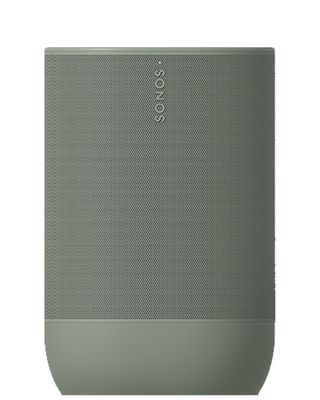
Best movability
Portability first came to Sonos with the Move, and the Move 2 retains the same dimensions yet sounds so much better and presents more ways to stay connected with it.
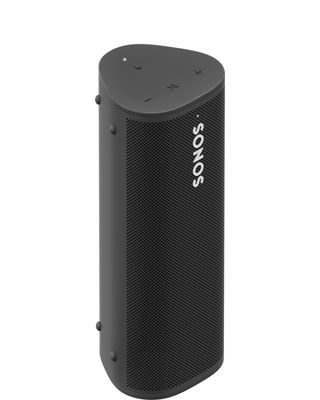
Best portability
The most portable Sonos speaker by a long shot, the Roam is more about convenience than producing booming sound in a small package.

Best small soundbar
The new Sonos Beam (Gen 2) offers impressive surround sound from a soundbar with Dolby Atmos support and the ability to pair it with rear speakers for true surround sound.

Best spatial audio
The Sonos Era 300 marks the company's first foray into spatial audio, playing tracks that are tuned for a surround experience from sources that can play them for you.
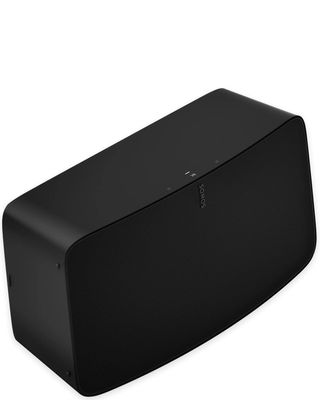
Best sound
The Sonos Five is the speaker you look to when you want the best sound Sonos can deliver. It not only booms, it also clarifies, pumping out tunes with real verve and precision.
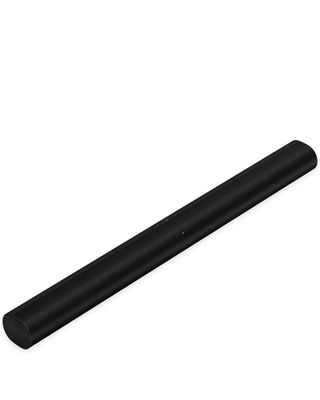
Best home theater
The Sonos Arc is what you get when you're ready to step up your home theater game and take sound to the next level, including if you pair it with rears for true surround sound.

Best accessory
Have existing speakers or a receiver? Bring them into the Sonos ecosystem by setting up the Port as a go-between to connect them and let you play audio wirelessly in a multiroom setup.
Best overall
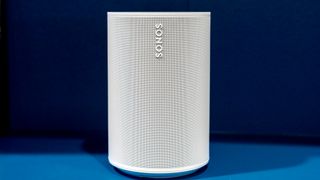
1. Sonos Era 100
Our expert review:
Reasons to buy
Reasons to avoid
With an impressive portfolio, one of the best Sonos speakers standing out for most people is the Sonos Era 100. This is a wholly redesigned take on the company's most entry-level option, not just because of the taller body but also the components inside that give the sound a louder jolt over the previous Sonos One.
The Sonos One was one of our favorite Sonos speakers for a lot of reasons, not least of which is how compact it was. The Era 100 largely sticks to a similar footprint, making it easy to put where you want and enjoy great sound that belies its frame. Audio is crisp, full of life, and miles ahead of those typical smart speakers coming from Google or Amazon. The only catch is you won't get Google Assistant to work on this speaker. At least not until legal issues with Google are squared up.
Still, the Era 100 has superb far-field microphones, allowing you to talk to both Google Assistant and Sonos' own voice assistant for basic commands. With Alexa, you can control playback and smart home devices. The connectivity doesn't end there. AirPlay 2 support puts you right in the Apple ecosystem, while Bluetooth lets you play audio on the speaker from any source. Not to mention the Aux-In USB-C port for turntables, etc., though you will need an adapter for it.
On top of all that, you get the usual array of Sonos perks. Pair two Era 100s together for stereo sound, or use two of them as rears in a surround sound setup. The Sonos mobile app continues to a be solid source of control, especially when using the Era 100 as part of a multiroom Sonos speaker system throughout your home for simultaneous music playback.
Best budget choice

Reasons to buy
Reasons to avoid
If you really like what you see with the Sonos One or Era 100 but don't care about using it to talk to virtual assistants, take a look at the Sonos One SL. This is the same speaker as the Sonos One, offering the same sound quality, pairing capabilities with two One SLs for stereo sound (or rears for surround sound), and the ability to be controlled and used with other Sonos speakers with the Sonos app.
The only difference is that you can't use it to interact with Google Assistant or Alexa. You also don't get Bluetooth like you do with the Era 100.
AirPlay 2, however, is still present on the One SL, so you can still tap into content via Apple's device ecosystem. It may be worth spending the extra money on the Sonos One because it still works with Google Assistant, but apart from that, it is the same as the One SL.
Best movability

Reasons to buy
Reasons to avoid
When Sonos finally released its first wireless speaker in the Sonos Move, it opened the gates to taking the company's audio experience beyond the home's walls. In our review, we found the Move 2 a noticeable upgrade in audio performance, owing largely to a stereo setup and better components inside. What you get is not only clearer sound over the previous Move, but also far bolder playback than anything the Sonos Roam can manage. This speaker is closer in many ways to the Era 100, though is priced above it, which could be an issue for tighter budgets.
You'll need to stick with the Sonos Five (more on that later) for the best possible sound Sonos has to offer in a speaker, while the Era 300 is right up there as well, but this is still a solid alternative between them if you want something to carry around. The microphones are solid, letting you talk to Alexa and Sonos Voice Control, though you lose out on Google Assistant. Have an iOS device or Mac? You can always stream wirelessly via AirPlay 2.
You can set up the Sonos Move 2 as a stationary speaker in your home, but the real draw is the fact you can take it off its charging dock and take it with you. The built-in handle makes it easy to transport but the 6.61-lb (3 kg) weight won't feel very feathery. Battery life takes an impressive leap with double the life of its predecessor, lasting up to 24 hours per charge. An IP56 rating offers decent protection from the elements, making it ideal for the backyard, park, or pool. If anything happens to go wrong with, it's easier to repair, and there's a special do-it-yourself toolkit to replace the battery, if necessary.
Best portability

Reasons to buy
Reasons to avoid
A portable speaker similar to some small Bluetooth models out in the wild was like the last frontier for Sonos. But alas, the Sonos Roam finally came; we reviewed it and concluded that the company could take this level of portability seriously.
The Roam takes all the connectivity Sonos is known for and adds an additional layer of convenience in that you can use the speaker just about anywhere and everywhere. Roam around your home, and the speaker will play whatever you want using your Wi-Fi connection. Roam away from home, and the Bluetooth connection will keep you wirelessly linked so you can listen wherever you go. And with its rugged body, it makes it so much easier to take it to the park, pool, beach, or campground and not have to worry.
Unlike the larger Move, the Roam is so diminutive. It's like holding a water bottle that blares out audio. Pop it in a bag, and you're good to go. With support for Google Assistant and Alexa, plus AirPlay 2, you have a smart speaker that also plays nice that way. Battery life could be better for something this portable, but at least the sound quality is up to snuff, making it a little easier to forget such a shortcoming.
Best small soundbar
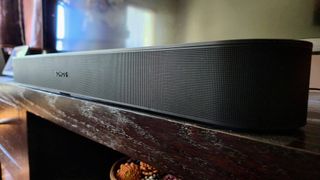
Reasons to buy
Reasons to avoid
A good soundbar can take your TV experience to the next level, and Sonos tried to address the size and output combination with the Beam (Gen 2). It is, in many ways, similar to the original Sonos Beam, though it differs in a couple of key respects, as we pointed out in our review.
It maintains the same size, which is to say that it's not long or cumbersome at all. The one major difference being that there is no more fabric on the front of the speakers, and it's all perforated plastic now. You'll be surprised with just how small of a footprint it actually takes up — making it a great choice for people with limited space on their TV stand. Setup is also a breeze, as the Beam (Gen 2) maintains the same approach. Plug in its power cord and connect the soundbar to your TV with the included HDMI cable, and that's all there is to it.
Sonos didn't change the speakers so that you will hear the same solid bass. Crank up the volume without any noticeable distortion, and everything from movies to music all sound excellent. Unlike the previous Beam, this one supports Dolby Atmos, so it's best to connect it to your TV's eARC port. And if your TV has an HDMI 2.1 port, you can say goodbye to any audio/video sync issues.
It's just a shame none of the speakers point up to try bouncing sound off the ceiling for more of that virtual effect Atmos is known for. The good news is that you get plenty of support. It works with both Alexa and Google Assistant, along with Apple's AirPlay 2. If you want, pair the Beam with Sonos Eras, Ones, Fives, and the company's Sonos Sub subwoofer to create a true surround sound system.
Best spatial audio
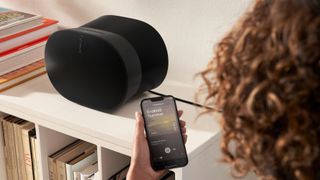
6. Sonos Era 300
Our expert review:
Reasons to buy
Reasons to avoid
Sonos launched the Era 300 at the same time as the Era 100, but they are very different speakers for a few reasons. The first simply comes down to the design, size, and power under the hood. This speaker can get loud, and its concave form factor is specially designed to push audio out in multiple directions for better stereo separation.
The more obvious difference is in spatial audio — a first for Sonos in this speaker — letting you listen to Dolby Atmos tracks from supported services in virtual surround sound. The speaker effectively delivers a resonant soundstage that tricks you into thinking audio is enveloping the room. Just as impressive is the speaker's ability to play hi-res audio tracks, pumping out greater detail from the sources, providing CD quality and higher bit rates.
Beyond the Wi-Fi connection, you also get Bluetooth to pair with any playback device, as well as the USB-C Aux-In port also found in the Era 100. AirPlay 2 plays nice with Apple's ecosystem, complementing the other options to cover a lot of ground in getting audio to play on here. Not to mention the USB-C Aux-In port in the rear to connect other components (adapter sold separately).
Like the Era 100, you can also put two Era 300s together for a stereo pair or use two of them with a Beam or Arc as rears in a surround system. While it's technically possible to connect one or both Era 300s directly to a TV, Sonos says it wasn't designed to be a sound bar replacement.
Best sound
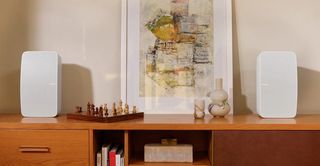
7. Sonos Five
Our expert review:
Reasons to buy
Reasons to avoid
None of Sonos's speakers are considered cheap, but if you want to go overboard and "treat yo' self" to something especially nice, the Sonos Five is the way to go. It's an update to the already-great Play:5 that debuted in 2015, and it keeps the same great audio quality while upgrading the internals to ensure it gets updates for years to come.
The Five ships with three custom-designed subwoofers, allowing it to kick out deep bass that gives all of your tunes immense power and force. The entire package is also sealed tightly, meaning that you won't put up with annoying echoes or reverb like what you'll find on other speakers of this size. Add that together with six digital amplifiers and six speakers, and the result is outstanding audio no matter what you're listening to.
If you can afford two Sonos Fives, you can pair them together for truly heart-stopping stereo sound. There's also support for AirPlay 2, Google Assistant, Amazon Alexa, and a 3.5mm headphone jack that allows you to plug in a turntable or phone.
Best home theater
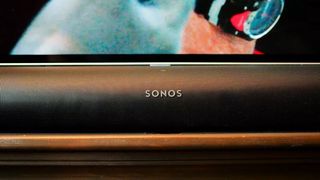
Reasons to buy
Reasons to avoid
While the Sonos Beam (Gen 2) is the best soundbar/TV speaker for most people, we felt the Arc was Sonos's most powerful product for your home theater setup when we tested it. It's long, bulky, and expensive, but there's no denying the sheer prowess offered by it.
You'll find 11 drivers total inside the Arc, which is a big improvement from the five in the Beam. This allows for even better sound quality, giving your movies, TV shows, and music that much more oomph. Also included in the Sonos Arc is Dolby Atmos, which creates a 3D listening experience unlike anything you've heard before.
Outside of the impressive audio quality, the Sonos Arc comes equipped with voice control via Google Assistant and Alexa, along with support for Apple's AirPlay 2. Set up is dead simple, as is expanding the Arc with additional gear like the Sub and One SL for a true surround sound system.
Best accessory

9. Sonos Port
Our expert review:
Reasons to buy
Reasons to avoid
Sonos speakers stand out for two main reasons: Sonos makes great-sounding speakers, and the seamless pairing and playback capabilities across multiple Sonos devices are ridiculously simple. With the Sonos Port, you even can introduce it to any old pair of non-smart stereo speakers you already have.
The Port has a variety of, well, ports on the back to connect to your old hardware, and once all set up; you can make your existing speakers a part of your Sonos ecosystem through the Port's interface. The line-in ports allow you to connect your record player, CD player, or another audio source, whereas the line-out ports support amplified audio equipment.
Also included with the Port are controls for treble and bass, AirPlay 2, and seamless management of everything through the Sonos app.
Sonos sound all over the place
Why you can trust Android Central
There's not a bad speaker in the entire Sonos lineup, but when looking at all the options, we think the best overall pick for most people is the Sonos Era 100.
The main reasons are that it's the one speaker that is the easiest point of entry into the Sonos ecosystem for newcomers and also one of the best for existing users to expand with. It's small enough to fit in most rooms, offers shockingly great sound quality for something compact, and has the awesome flexibility to work together with another Era 100 for stereo sound or rears in a surround setup with a Beam or Arc.
That it uses Alexa is a bonus, whereas the lack of Google Assistant is a bummer, but AirPlay 2 and Bluetooth support really open the floodgates for interoperability. Whatever you decide to do with the Sonos Era 100 it offers real value and functionality for its asking price.
Be an expert in 5 minutes
Get the latest news from Android Central, your trusted companion in the world of Android

Ted Kritsonis loves taking photos when the opportunity arises, be it on a camera or smartphone. Beyond sports and world history, you can find him tinkering with gadgets or enjoying a cigar. Often times, that will be with a pair of headphones or earbuds playing tunes. When he's not testing something, he's working on the next episode of his podcast, Tednologic.
